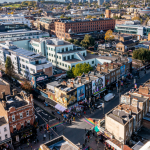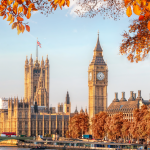Most of Shravan’s career to date has been – and indeed his current “day job” is – in the energy and finance sectors, but he is no stranger to property and planning. First elected to represent Bishopsgate on the Common Council at a by-election in 2018 , he has since then been an active member of the Planning & Transportation Committee, Licencing Committee, Streets and Walkways Sub-Committee, and the Property Investment Board.
This experience is reflected in his intimate knowledge of the City, coupled with an evident – and endearing – affection for the Square Mile as a place. Throughout our discussion, Shravan effortlessly reels off the names of streets, squares and alleyways while describing buildings, development schemes and area-focused policies, gesturing excitedly as if he’s physically there. That knowledge and passion are critical, as Shravan steps into a complex and challenging role, covering planning, transport, and the environment.
Shravan himself is very much alive to the scale of the task ahead. “Over lockdown, we went from a really vibrant urban setting to empty streets, closed offices and shuttered restaurants, but dealing with those changes first hand helped me understand some of the existential threats we now face and to start forming a strategy for recovery and for rebuilding that vibrancy we had pre-Covid.”
Collaboration is, of course, key to recovery. “I have a very empathetic view of the Square Mile” and engaging with industry is “really important to making sure we are creating policies and strategies that align to market needs”. Shravan is equally committed to ensuring that residents, educational institutions, livery companies, faith groups and other also “have a voice at the table, so that we are making sure to create an environment that suits all of the City’s diverse demographics”.
So what does the market need? “We are essentially a central business district”, says Shravan and “the office is at the heart of it”. “What we’re hearing more and more of is that we need a built environment that is more sustainable, meets the growing demand for low environmental impact, high-grade offices and also for spaces that people want to spend their leisure time in”. The City Corporation is aligned with industry in wanting to “drive people back in, to really high-quality office settings” with a renewed emphasis on “collaborative and flexible space.” The City has continued to support the office sector, including through securing an Article 4 direction to restrict the use of Permitted Development Rights in the Square Mile and Shravan is pleased to see that office lettings remain high.
He is, however, clear there has always been more to the City as a place: “you’ve got beautiful heritage assets right next to shiny skyscrapers, alongside medieval churches, guild and livery halls, new restaurants, bars and clubs, as well as residential homes in the Barbican and other estates – quite a diverse setting.”
Also key to the City’s past and future success is “the connectivity that brings the South East into the Square Mile”. Shravan hails the staged opening of the Elizabeth Line as “really opening up” London to its wider region (and vice versa). Public transport is a “critical element” of the City’s revival as a place of work, culture and leisure – and its rebirth as place with a greater emphasis on attracting new demographics, including families and tourists, seven days a week.
So what do these various priorities translate into, in policy terms?
First and foremost, the City Corporation has already published a new Destination City strategy, which seeks to bring together these various priorities into a coherent plan for recovery. It is also reviewing its City Plan, with a view to submitting a draft to an Inspector for examination in autumn 2023. That review is primarily intended to “embody our sustainability and net zero goals, address our policy on tall buildings as well as wider policies on urban greening”.
The debate between refurbish vs rebuild and carbon considerations in major development schemes is one that Shravan believes “we really need to address in this term” and a Planning Advisory Note was recently put out to consultation. “We are trying to provide a framework for the development community to understand the ‘bars to entry’ for each approach and “the sort of arguments we expect them to have considered” before bringing an application scheme forward.
Improving practices for engagement in planning is also a key priority: “we’re coming up with a new Statement of Community Involvement in the autumn of this year, which will embody our commitment to the residents living within the city, to make sure they are also catered for by planning – and that the transport and amenities that we have in the City are accessible and fit for purpose”.
The City Corporation’s Transport Strategy is also undergoing a review – “we are revisiting policies around active transport, taking into account TfL’s guidance for upgrading Bank, building extra capacity for pedestrianisation around critical junctions in the Square Mile”. He offers assurances that “we are certainly not moving away from our overarching strategy on pedestrianisation but we have to better accommodate the needs of groups with accessibility needs in our transport network”.
The City Corporation remains committed to creating “as much outdoor space use as we can” more generally, capitalising on the success of al fresco dining initiatives “catalysed” by the pandemic and creating new, accessible spaces with green canopy cover wherever possible. Shravan warns, however, that with footfall rising towards pre-pandemic levels (currently “at about 70% of what it was”) “we have to make sure that we do that safely, in a way that doesn’t lead to overcrowding”. He offers a reminder that outdoor space need not be limited to ground level – “we are really trying to advocate the use of terraces on some of our tall buildings as public spaces”, mentioning the imminent opening of a new public terrace at 22 Bishopsgate.
Asked whether there are any other exemplary projects he sees as already delivering on the priorities enshrined in these emerging policies, Shravan has a couple in mind.
He points to Pembroke’s recently opened 25 Cannon Street office scheme as “a really good example of a refurbishment, involving a tired office building in quite a critical corner of the City” and of a developer doing “something exciting”. He excitedly lists features like “a public garden that looks quite wild and has that biodiversity element right at the heart of it”; a reflective pool that makes for a great “Instagram spot”; and ground floor space for retail and hospitality on Watling Street, “opening that avenue up, from Bow Lane through to St Paul’s”. In all, “a really good example of how you can create a really strong urban statement with a refurbishment.”
He also mentions Evans Randall Investors’ recently-approved office plans for Thavies Inn House at Holborn Circus as a “great example of redevelopment” and “how you can take a building that is not prime real estate in its current form and really make a stamp on the area, helping the revitalisation of the whole Fleet Street quarter”. He points out the scheme’s provisions for tree planting, a new pocket park and high energy efficiency specifications – but also the way in which it has been brough forward through “a really good partnership” between developer, City Corporation and the Fleet Street Quarter Business Improvement District (BID).
Speaking of BIDs, Shravan hails their relatively recent proliferation in the City as “very exciting” and “pertinent”. He credits the Cheapside Business Alliance as “really helping revitalise that area”, with Aldgate Connect, EC BID and Fleet Street Quarter “following suit strongly”. EC BID is already “the biggest BID in the country” and presents “a real opportunity for a funded, targeted improvement of that urban environment … using the spaces that we have to the best effect”.
Toward the end of our interview, Shravan notably makes a stand on transport funding, arguing that “it’s vital that we have a fully-funded Transport for London”. On the one hand, for London itself, “it’s really important that people have confidence in the reliability and efficiency of the transport network, so that we get an active return to work – and because we don’t want a car-led recovery.” On the other, TfL is vital to ensuring that as a global centre for trade and innovation, “London is a springboard for success, for the South East and for the country more widely. You’re not going to get ‘levelling up’ without the capital performing and being effective in its own right”.
Ultimately, he says, “economic growth and prosperity is at the heart of our policy and that applies not just to the Square Mile, but to London and the UK as a whole. To me, the urban setting that we create is critical to the manifestation of that economic growth and prosperity, to draw businesses, the best talent, experience and skills into one location – and I see the Planning & Transportation Committee as being really central to that.”
This interview was conducted by London Communications Agency on behalf of the London Property Alliance as part of its curation of the monthly Central London Planning & Politics newsletter.
Read more from our London Leaders series here.


